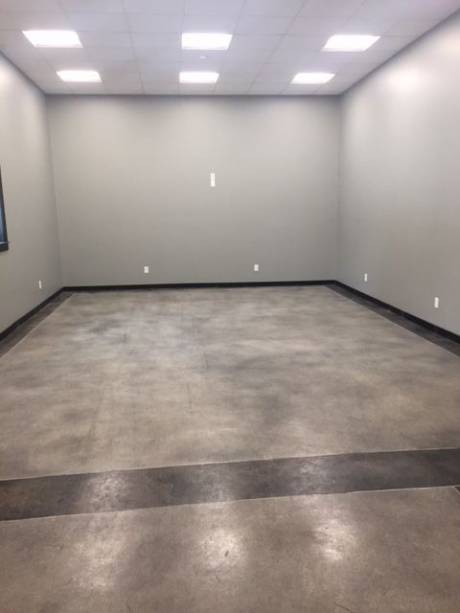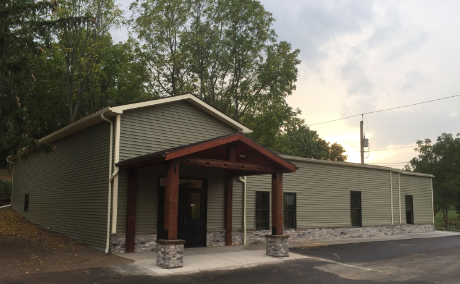
Above photo is the former water distribution building adjacent to Hartland Park in Bergen, after it was repurposed into the Sage Pavilion.
BERGEN -- Preserving Bergen’s history, promoting the village and conserving energy to save taxpayers money have long been a focus of the Village of Bergen.
That dedication recently won the Village of Bergen an award from the American Public Works Association as their WNY Public Works Project of the Year for repurposing of its former water distribution/Department of Public Works building into the Sage Pavilion.
The cement block building adjacent to Hartland Park had been empty for decades and the village had considered demolishing it.
Examples of the village’s sustainability practices in previous years include purchase and repurposing of the Tulley Building for village offices, boardroom, document storage facility in the basement, rental space for business; and four apartments.
Other examples are the composting facility at the Water Treatment Plant, community garden, Tree City recognition, Bergen Electric Efficiency Program, Clean Community designation and recycling efforts.
Transforming a DPW building into Sage Pavilion
The Sage Pavilion is the result of their latest efforts, said mayor Anna Marie Barclay.
The village first learned about the American Public Works Association’s award from engineers Clark Patterson & Lee, who told the village of the opportunity to apply.
“We applied and talked about how our staff came together and how the communities around us supported us,” Barclay said.
Village Administrator Cortney Gale said after the water treatment plant closed, the DPW kept their trucks there, followed by 10 years of use as a cold storage.
“But it got pretty gross,” Gale said.
The cost for the village to build a much needed public pavilion was prohibitive, the mayor wrote in the application.
“The village is small and budgets are tight,” the mayor wrote. In order to provide the village residents and outside community with the all-season pavilion needed, the village staff had to be creative.”
The need for a village pavilion became evident after the Bergen Fire Company converted its community hall into space for town offices and town courtroom.
“The village lost a facility that had been used for community and family celebrations and meetings,” Barclay wrote in the award application.
Since an all-season pavilion had been strongly requested at public hearings during development of the 2016 comprehensive plan, staff worked to develop a plan to make the pavilion a reality.”
A new building similar to the now completed Sage Pavilion would cost $750,000 based on normal construction costs and using public bidding and state wage rates.
Demolition of 'eyesore' was considered
The village board was considering demolition of the eyesore, but after cleaning out the materials from the building, the space led to discussions of possible refurbishing. The building was found to be structurally sound, on the main road and centrally located across from Hickory Park and adjacent to Hartland Park and the disc golf course.
The village engineer and staff met to set a plan in place, and chose to convert the former water building.
A SAM grant was applied for and awarded through sponsorship of Senator Michael Ranzenhofer, providing seed money for the project.
Interior walls were made of Bergen Brick manufactured in the village of Bergen. A transom window originally over the entry door to the former office area of the water plant was repurposed as a decorative addition to the Sage Pavilion entry hall.
The biggest challenge to the project was removing giant pumps three levels into the ground and then filling in the space. The village did not have equipment to remove the pumps and having a contractor fill in the basement was cost prohibitive.
Planning to meet the challenges
A plan was devised to use the electric department pole, setting trucks to hoist cast iron pumps and pipes out of the basement through an open window and the former basement stairway. The cast iron pumps and piping were hauled to a nearby scrap yard and the funds reinvested into the building.
Discussions with DPW staff, the engineer and village code enforcement officer led to a strategy for filling in the basements. It was determined road millings could be used as fill, topped with flowable fill. Not only would this save the village a tremendous amount of money, but it would help surrounding communities which were doing road work to dispose of their road millings.
The village contacted local communities during road work and arranged for the town of Bergen to pick up the millings and bring them to the construction site.
Village linemen chipped in to do landscaping and every single village employee helped with siding, windows, roofing and piping in the floor for radiant heating, Gale said. The process took a year and a half.
The village employees spent a lot of time huddled over their computers, watching YouTube for information on how to perform certain aspects of the project.
During demolition, it was discovered a fire many years ago had damaged the building. That area was sealed per current codes and left exposed to show the history of the building.
As work progressed, people using the nearby walking trail and employees who used to work in the old water plant often stopped to view the work.
Wowed by the work
“They would look around and ask how it was possible this was the same building,” Barclay said.
When it came to choosing a name for the new pavilion, the village settled on that of W. Monroe Sage, elected the first mayor of the village of Bergen in 1877, and then reelected in 1902. Born in 1834 in the town of Wheatland, Sage was well-known in music circles.
He was the prime mover in bringing about the incorporation of the Village of Bergen and instrumental in having sidewalks placed. He also inaugurated the first streetlighting by placing lamps on the corners of North Lake Avenue, Rochester and Buffalo streets.
The entire Village of Bergen staff are planning to attend the award presentation Jan. 31 at RIT’s Banquet Center in Rochester.
Photos by Virginia Kropf.
Photo below is what the former Bergen water/DPW building looked like in 2016, before work began to transform it into a public pavilion.
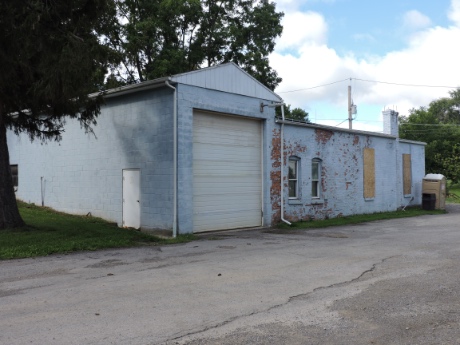
The next two photos below show what Bergen’s former water treatment plant looked like inside as work began to transform it into a public pavilion.
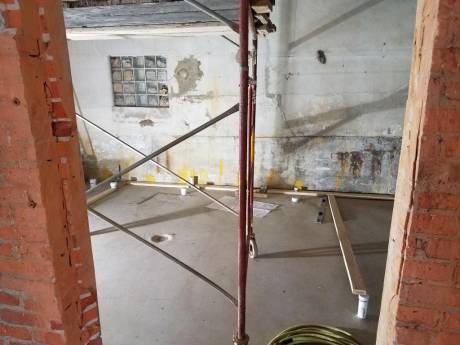
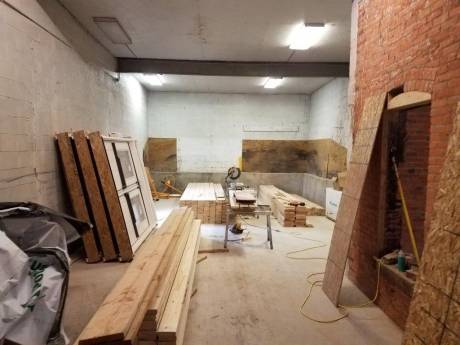
The bottom two pictures show the meeting room and entranceway to the Sage Pavilion after renovations were completed.
